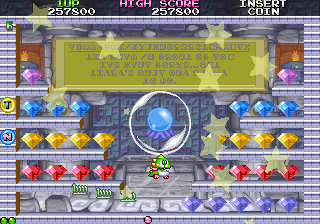
EDITOR'S NOTE:
Oh no, they're talking about Bubble Symphony. Oh no.
You don't understand- once they start talking about this game, they can't be stopped.
Get a strong drink or something.























| Prototype | Final | ||||||||||||||||||||||||||||||||||
|---|---|---|---|---|---|---|---|---|---|---|---|---|---|---|---|---|---|---|---|---|---|---|---|---|---|---|---|---|---|---|---|---|---|---|---|
| The attract mode is missing the Taito logo, the title screen, the two story intros, the high-score table and the game's logo during demo sequences. It starts with Bubblun's profile, goes onto the tutorial, shows the remaining profiles interspersed with gameplay demos, then restarts from Bubblun | The attract mode is far longer, starting with the Taito logo and moving on to the title sequence. It adds the game's logo during demo sequences, the high-score table and the two story introductions | ||||||||||||||||||||||||||||||||||
| After starting a game, the intro screen reads "The New Adventure of "Bubble Bobble" - The Return of Super Drunk" | After starting a game, the intro screen reads "The New Adventure of "Bubble Bobble" - The Next Generation" | ||||||||||||||||||||||||||||||||||
| Upon losing your last life, you are given 10 seconds to continue, with no extra item as an incentive | Upon losing your last life, you are given 20 seconds to continue, and continuing gives you an item that cycles quickly between all three sweets and the red shoes- grab it to get one of them | ||||||||||||||||||||||||||||||||||
| Continuing does not alter your score | Continuing adds a single point to your score until you reach 9, where it stops being added | ||||||||||||||||||||||||||||||||||
| Score values for grabbed items pulsate slightly as they rise up the screen | Score values just rise up the screen and do not pulse | ||||||||||||||||||||||||||||||||||
| After grabbing a magic potion while fighting a boss, your bubble-blowing speed will stay as it is | After grabbing a magic potion while fighting a boss, your bubble-blowing speed will increase as if you've grabbed a yellow/green sweet | ||||||||||||||||||||||||||||||||||
| One of the special items in the game is the Yellow Shoe, which increases your speed to almost uncontrollable levels | The Yellow Shoe is no longer present, the fastest you can move is when you grab the Red Shoe item | ||||||||||||||||||||||||||||||||||
| When you are killed, your character will fall down the screen and pass through any platforms until they disappear | When you are killed, your character will fall down the screen but stop if they land on a platform before they disappear | ||||||||||||||||||||||||||||||||||
| The game's music is entirely taken from the original Bubble Bobble, including the main theme, the character select screen (adapted from the main theme), the Chack'n Heart/Bonus music (from the same situations in the original) and upon boot-up, the game plays the Game Over jingle. No special music plays during the boss fights. | Although the game has new music normally, entering the code Bubble, Jump, Bubble, Jump, Bubble, Jump, Right, P1 Start (the Original Mode code from the first game) on the title screen will remove all backgrounds and make the original Bubble Bobble theme play! It's a different version from the one in the prototype, though. | ||||||||||||||||||||||||||||||||||
| The charge-shot has not been implemented yet- holding down the Bubble button does nothing | - | ||||||||||||||||||||||||||||||||||
| The game is considerably slower at this point, including your movement and the movement of enemies | - | ||||||||||||||||||||||||||||||||||
| Altering your fall speed by holding Up or Down has not been implemented yet | - | ||||||||||||||||||||||||||||||||||
| The available Special Bubbles are Fire, Water, Lightning and Rainbow. Wind and Music haven't been implemented yet. | - | ||||||||||||||||||||||||||||||||||
| In addition to not appearing in the intro, the high score table is not implemented at all- even if you break the high score, you are never asked for your name. | - | ||||||||||||||||||||||||||||||||||
| At this point there are only twelve monsters in the game. Seven come from the original Bubble Bobble (Zen-chan, Maita, Monsta, PulPul. Hidegons, Banebou and Invader) and five are new (Dorabo, Knightron, Uni Bo, Magician and Dranko, who is referred to by one stage name as Drunko- her male counterpart's not in the game yet!) | - | ||||||||||||||||||||||||||||||||||
| After clearing three worlds, the game ends with this screen and takes you back to the attract mode. | - | ||||||||||||||||||||||||||||||||||
| The hidden musical notes (now just notes instead of in boxes) are implemented but work differently- you have to collect every hidden musical note in a world, and the chest at the end of the world contains the key and more musical note items. All the keys in the game are red, however they don't unlock anything at this point | - |

